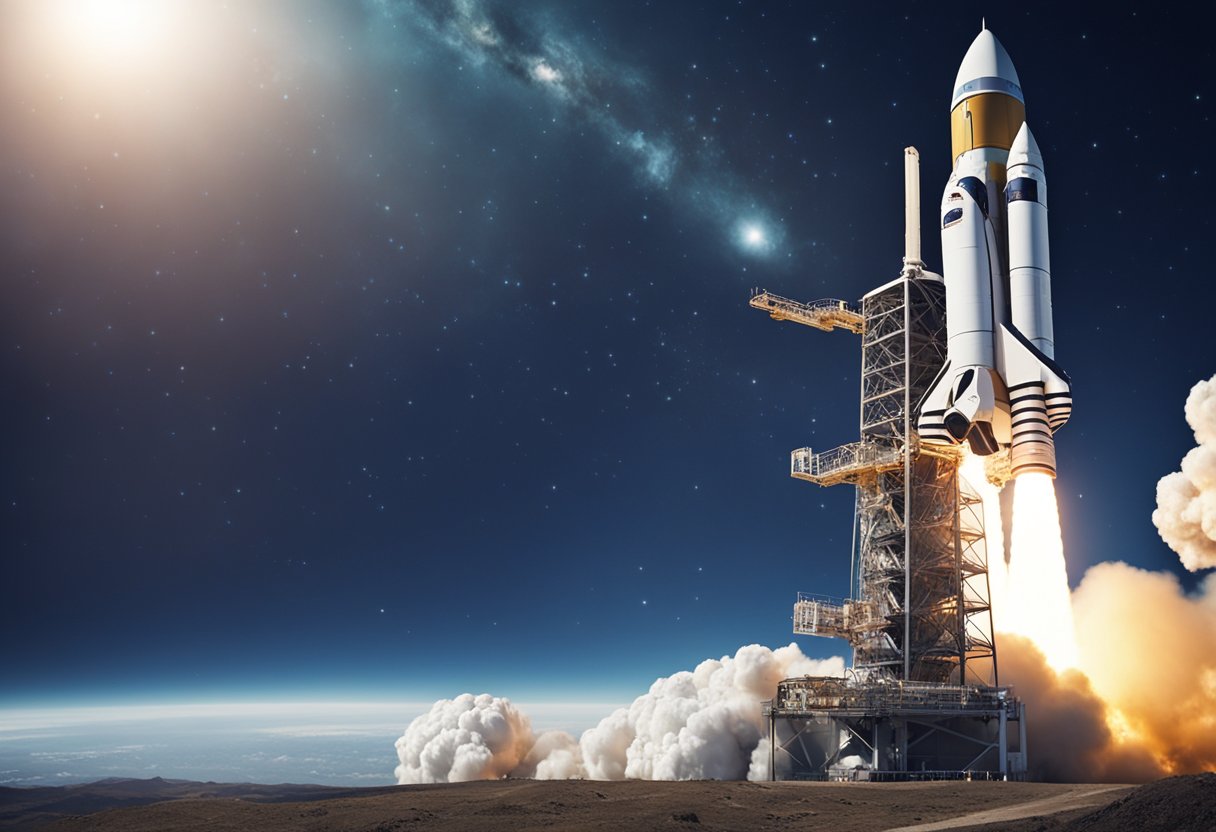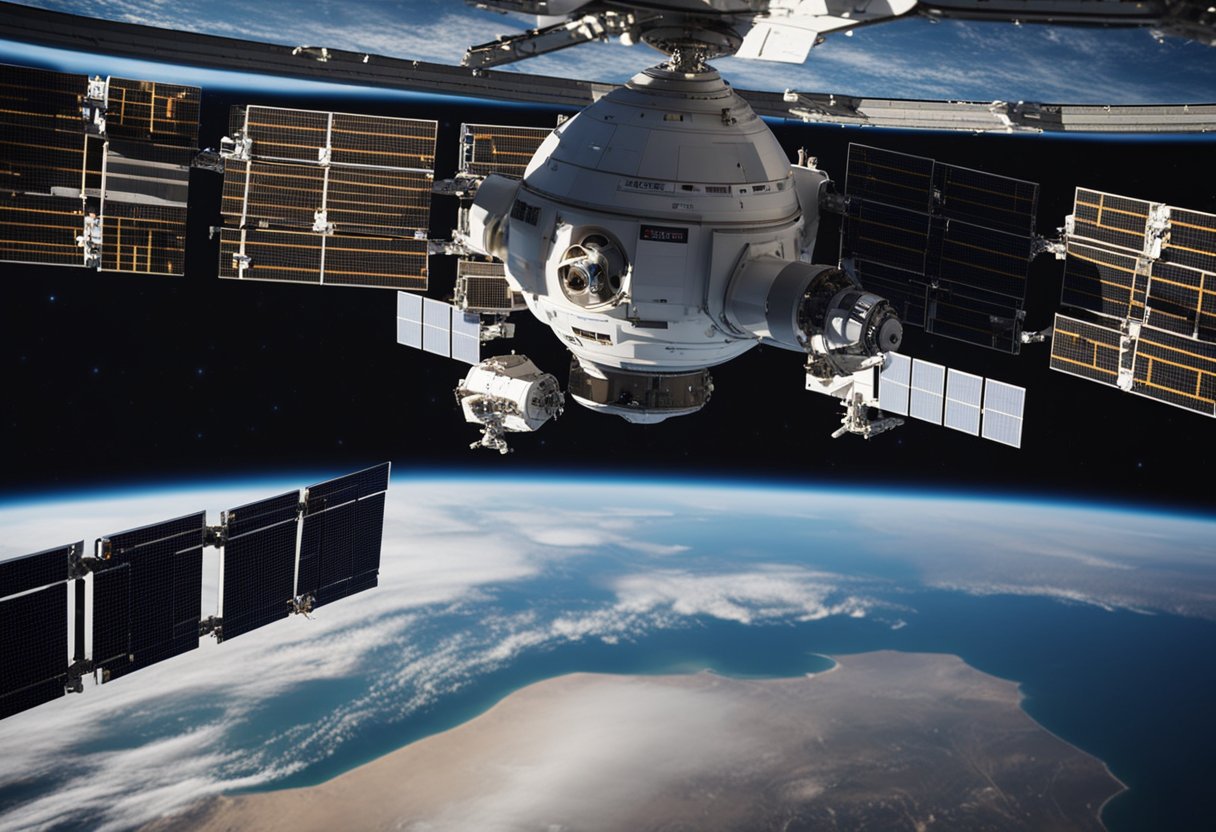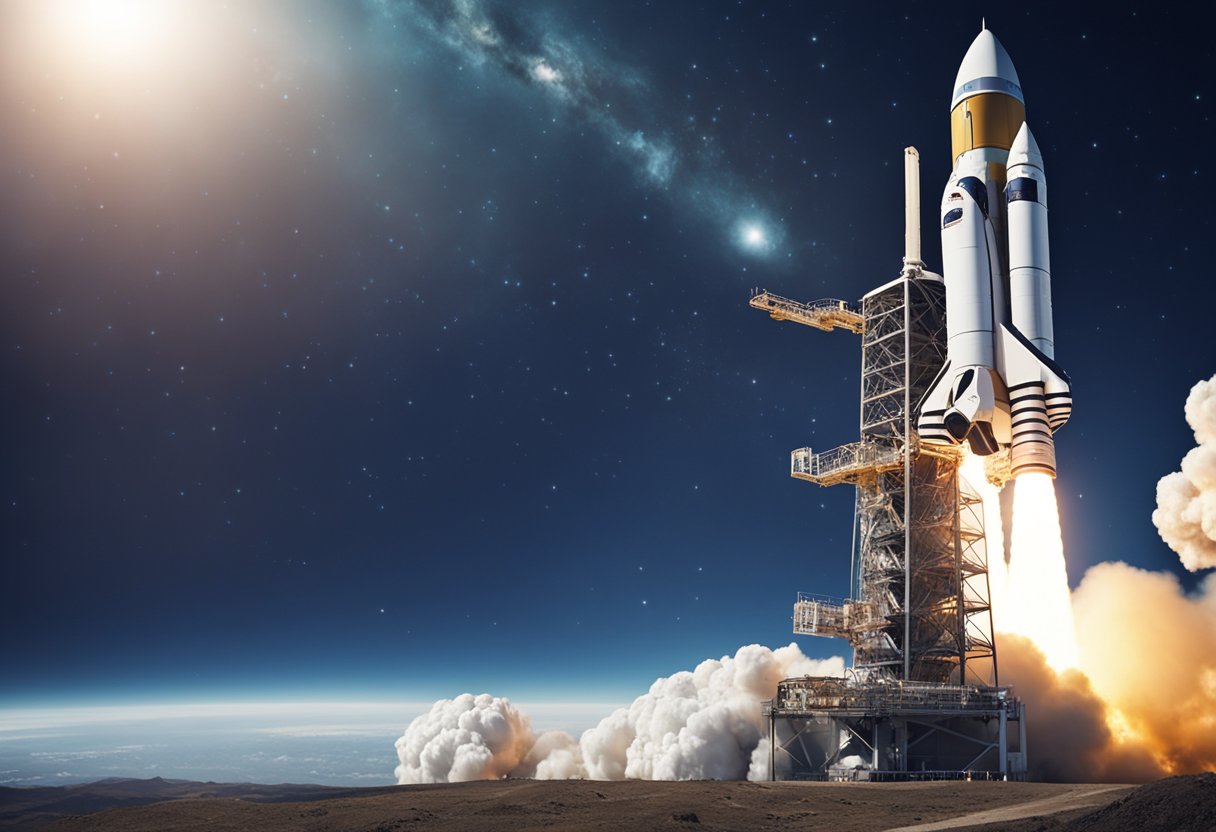
Innovations in Space Tourism – Space tourism once belonged to the realms of science fiction, but today it stands on the cusp of reality. As a testament to human ambition and ingenuity, we have witnessed the transformation of space travel from an exclusive playground for astronauts to a burgeoning industry promising orbital experiences to the public. Innovations in propulsion technology, spacecraft design, and commercial business models have turned the dream of civilian space travel into a tangible goal within reach.

It is an exciting time for us as space enthusiasts and potential travellers, as we observe the rapid evolution of companies like SpaceX and Virgin Galactic developing programs specifically designed for consumer space travel. This transition from governmental to private sector-driven space exploration is not only expanding access to space but also driving down costs, making the final frontier ever more accessible. Furthermore, recognising the curiosity and desire for exploration that propels humanity, new ventures such as SpaceVoyageVentures.com catalogue both existing trips and those on the horizon of space tourism.
In this section, we’re exploring the trajectory of space tourism from its early imaginative concepts to the groundbreaking commercial milestones that have brought the cosmos within reach of private citizens.
Space tourism began as a mere figment of our collective imagination, with visionary ideas rooted in science fiction. The possibility of civilians travelling beyond Earth’s atmosphere cropped up through literature and media, inspiring a fascination with the cosmos that ignited relentless curiosity.
Over the past few decades, significant strides have been made towards turning these dreams into reality. Virgin Galactic, spearheaded by Richard Branson, emerged as one of the pivotal forces, committed to creating a space tourism industry from as early as the 2000s. Other influential figures, namely Jeff Bezos with his company Blue Origin and Elon Musk with SpaceX, have since joined the venture, turning what was once a fanciful idea into a palpable opportunity for exploration and adventure.
The commercialisation of space travel has seen tangible progress, with Virgin Galactic successfully sending its founder Richard Branson to the edge of space. This epochal event signalled a new era for space tourism, marking our transition from mere observers to active participants in space exploration.
Our interest in the cosmos, fuelled by the ambitions of these trailblazers, reflects a growing demand for experiences that were once exclusive to astronauts. Thanks to their efforts, the day is nearing where space tourism extends beyond a privileged few, as companies like SpaceVoyageVentures.com document the current and forthcoming opportunities to venture into the final frontier.
In the burgeoning industry of space tourism, several companies have made significant strides, paving the way for private individuals to experience the wonder of space travel.
SpaceX, founded by Elon Musk, has redefined space technology with its advanced rockets and spacecraft. They’ve succeeded in launching the Falcon Heavy, the most powerful operational rocket in the world by a factor of two, and are now developing the Starship, which aims to carry passengers on long-duration spaceflights. Their achievements in reusable rockets are making space travel more accessible and affordable.
Blue Origin, the brainchild of Jeff Bezos, has made substantial contributions to space tourism with its New Shepard suborbital vehicle. Designed to take astronauts and research payloads past the Kármán line – the internationally recognized boundary of space – Blue Origin’s New Shepard has already completed several successful test flights. Space tourism is becoming more tangible thanks to their efforts in creating a reliable and safe suborbital experience.
Under the leadership of Richard Branson, Virgin Galactic has made impressive progress, focusing on providing suborbital spaceflights to tourists. Through rigorous testing and development, they’ve launched multiple crewed flights of their SpaceShipTwo spaceplane, inching closer to offering commercial service. Virgin Galactic’s advancements show promise for a new era of accessible space travel.
We must also mention SpaceVoyageVentures.com, an emerging platform in the space tourism industry, documenting the possible future tourism trips as well as those currently available and nearing availability. As we continue to watch this sector progress, we remain confident in the potential of these enterprises to shape the future of human space travel.
Innovations in launch systems, spacecraft design, and safety measures are crucial advancements fuelling our ventures into space tourism.
We’re witnessing a revolutionary change in launch systems, with reusable rockets becoming a cornerstone for sustainable space tourism. Companies like SpaceX have led the way with their Falcon rockets, drastically reducing the cost of reaching orbit. This pushes us closer to a future where space travel could mirror today’s airline industry in frequency and accessibility. Additionally, initiatives like Virgin Galactic’s air-launched spacecraft are paving a new path for suborbital tourism, offering brief experiences of zero-g without the need for traditional rocket launches.
Spacecraft design has evolved significantly from the utilitarian capsules of early space missions. Emphasis on comfort and viewing opportunities is paramount, with features such as large windows for Earth observation—a design philosophy evident in the Blue Origin New Shepard’s capsule. Modular designs also allow for customisation of the interior space, accommodating everything from research missions to luxury tourist experiences, as catalogued on early industry websites like SpaceVoyageVentures.com.
Ensuring passenger safety is the pinnacle of our endeavours as we push the boundaries of space technology. Rigorous training for passengers and the development of autonomous life-support systems have been prioritised. Crew escape mechanisms, redundancy in critical systems, and advances in materials science for improved heat shielding upon re-entry encompass our exhaustive approaches to safety measures. These innovations are modeled with an aviation-like ethos; however, they’re tailored to meet the unique challenges of the space environment.
In recent years, we’ve seen private companies become pivotal contributors to the field of space tourism, opening new avenues for funding, innovation, and collaboration that were previously uncharted.
The rapid growth in space tourism has been significantly fuelled by private investment. Companies like Virgin Galactic, Blue Origin, and SpaceX have secured substantial funding, enabling them to pursue ambitious projects and breakthrough technologies. Private investment not only drives innovation but also reduces governmental financial burdens, creating a symbiotic environment for space tourism to thrive.
Our collaborative efforts with NASA reflect a strategic partnership that leverages both governmental and private resources. NASA‘s Commercial Crew Program has been instrumental in this regard, with SpaceX making history by transporting astronauts to the International Space Station. These partnerships are vital for achieving technological advancements and proving the viability of commercial spaceflight.
Moreover, exploring the potential of space tourism, websites like SpaceVoyageVentures.com document the evolving landscape of opportunities for the public to engage in space travel, signalling the transition towards more inclusive and accessible space experiences.
In pioneering the domain of space tourism, we must pay close attention to the intricate web of legal and ethical considerations that govern space activities. From ensuring the safety of spacefarers to protecting the celestial environment, these aspects are crucial for the sustainability of space tourism.
International coordination is paramount in space tourism, as the activity transcends national boundaries. The Outer Space Treaty, as the foundational United Nations treaty, outlines that the exploration of outer space shall be done for the benefit of all countries. Thus, no nation can claim sovereignty over outer space or celestial bodies. When considering operations such as those involving the International Space Station, regulations from the International Telecommunication Union (ITU) and agreements like the Registration Convention must be adhered to. Parties involved in space travel must ensure that their activities are harmonised with these laws to avoid conflicts and liabilities.
Regarding the legalities of companies like those documented on SpaceVoyageVentures.com, obtaining the correct licenses and ensuring the adherence to safety and liability frameworks is non-negotiable. These permits regulate the conduct of space vehicles and their operators, ensuring that the safety of participants is not compromised.
Space tourism’s environmental impact on Earth and in space is an emerging ethical dilemma. The environment must be protected from potential harm caused by space debris and the operation of spacecraft, which could contribute to climate change. It’s our duty to mitigate these environmental impacts, such as the carbon footprint of rocket launches, as well as the contamination of celestial bodies.
Current guidelines and best practices encourage the minimisation of space debris and contamination. Any entity looking to step into the industry must not only abide by these guidelines but also strive to innovate in ways that reduce the ecological footprint of space travel. Our commitment to the environment must be unwavering, not only for the sake of current generations but also to safeguard the cosmos for those yet to come.
In recent years, we have seen a significant shift towards the commercialisation of the final frontier, and with this shift, it’s imperative to consider the economic implications of space tourism. Our focus here will be a dissection of the costs involved and an assessment of market prospects.
As we scrutinise the current landscape of space tourism, it’s clear that the cost remains a considerable factor. Ticket prices for a space journey are projected to range from US$200,000 to US$300,000,according to Blue Origin, with similar figures proposed by other companies. It’s essential for us to conduct thorough data analysis on these costs to understand the full economic impact. For pioneers in the industry, such as Virgin Galactic, the recent successful suborbital test flights have not only marked a significant technological milestone but have also provided valuable data for cost analysis. This information from early adopters like SpaceVoyageVentures.com offers a glimpse into both the current economic climate of space tourism and its potential trajectory.
Looking ahead to the future market, it’s reported that space tourism could burgeon into an industry worth over $800 billion by 2030. Our market forecasting involves dissecting this data and considering technological innovations, increasing commercialisation, and sustainability measures as key drivers. The year 2024 is predicted to be pivotal for the space economy, following noteworthy achievements and plans set in 2023. It is our collective endeavour to remain at the forefront of these developments, supporting economic studies and providing accurate forecasting that stakeholders can rely on. This information will be critical for businesses like SpaceVoyageVentures.com and others looking to capitalise on the burgeoning space tourism sector.

In this section, we explore the roles of different countries in the arena of space tourism, highlighting the diverse contributions to this high-flying industry.
Russia has long been a key player in space exploration, and it has extended its expertise into space tourism. Historically, the country’s space agency, Roscosmos, was the first to facilitate private space travel by sending paying passengers to the International Space Station. Most notably, they provided the opportunity for the first space tourist, Dennis Tito, to visit the ISS in 2001. In keeping with their pioneering spirit, Russia continues to offer options for private trips to space, anticipating future collaborations with various international partners.
Japan has made significant strides in space travel, contributing to both technology and research. The Japanese space agency, JAXA, has been actively involved in international projects like the ISS, and its private sector is rapidly becoming integral to space tourism. With innovations in spacecraft design and satellite technology, Japanese companies are poised to offer unique experiences to tourists seeking the thrills of space. Moreover, initiatives such as the Space Tourism and the Space Economy underscore Japan’s commitment to advancing the global space tourism industry.
Japanese firms are also known for their meticulous safety standards, which are paramount in the context of space travel. Their expertise in robotics and automation could lend to a smoother and safer journey for future space tourists, enhancing international cooperation in this sector.
In this section, we explore the evolving concepts and destinations that are shaping the future of space tourism. From audacious Mars expeditions to lunar escapes, these ventures are turning science fiction into reality.
Mars, often coined as the next frontier, represents a bold step for human exploration and potential tourism. Our sights are set on the Red Planet as a key location for futuristic exploration. Companies like SpaceX are working on projects like the Starship, which is designed to carry humans to Mars. The journey to Mars would not only be a monumental leap in space travel but a testament to human ingenuity and endurance.
The moon, our closest celestial neighbour, has always captivated our collective imagination. With plans for lunar tourism taking shape, the concept of holidaying on the moon is moving from fantasy to possibility. Offering a unique experience, tourism initiatives may include visits to the lunar surface, stays in orbital hotels, or even trips to historical landing sites. This nascent industry could be facilitated by partnerships with organisations like NASA and private companies such as SpaceX and Blue Origin, which are developing the necessary technology for lunar expeditions.
Furthermore, entities like SpaceVoyageVentures.com provide insight into these exhilarating ventures, documenting the potential future trips and those nearly within our grasp.
We are at the cusp of a new era where scientific research and space innovation are driving the growing industry of space tourism, leveraging advanced space technology and satellite capabilities.
The advent of space tourism provides a unique platform for conducting scientific experiments in microgravity conditions. Our understanding of physics, biology, and human physiology is greatly enhanced through research conducted in space. Private companies now offer opportunities for research institutions to send experiments on suborbital flights, which was previously a privilege reserved for government space agencies. Studies range from the effects of zero gravity on various materials to medical studies pertinent to long-duration space travel.
Satellite technology, critical to space tourism, has seen significant advancements that benefit both tourists and researchers. We’ve witnessed the development of miniaturised satellites, such as CubeSats, which offer a lower-cost option for conducting space research and have implications for improving global communications – a backbone of safe and reliable space travel. Our capacity to monitor and analyse space weather, which is vital to the safety of space tourists, has improved with innovations in satellite sensors and instrumentation.
Satellites also play an instrumental role in navigation for spacecraft and in transmitting live experiences back to Earth, making space more accessible to people around the globe. We are contributing to this venture, embracing the potential that satellite technology holds for future space tourism. For further insights into current and imminent space tourism endeavours, visit SpaceVoyageVentures.com.
We understand the profound role that space tourism plays in inspiring public interest and enhancing education. Companies at the forefront of this burgeoning industry, such as SpaceX, are not just looking to launch tourists into orbit; they’re also committed to cultivating a more informed society regarding space exploration.
Public Interest:
Educational Initiatives:
Outreach Programmes:
By intertwining space tourism with education and outreach, we’re not only fuelling individual dreams of interstellar travel but also ensuring that the wider public remains informed and enthusiastic about space’s infinite possibilities. Our mission extends beyond tourism; it’s about cultivating a future where space is within the reach of everyone’s understanding.

In exploring the burgeoning frontier of space tourism, we’re confronted with considerable challenges and limitations that shape the industry’s trajectory.
The technical hurdles of space exploration are onerous. Launching and safely returning a spacecraft demands not only cutting-edge technology but also rigorous safety protocols. A key challenge lies in developing reliable systems that can withstand the harsh environment of space. From thermal protection to life support, every component must function flawlessly to ensure the safety of space tourists. Issues such as the creation of spacecraft capable of multiple re-entries are taxing both in terms of cost and engineering prowess.
Frequent launches and landings necessitate the construction of durable spacecraft, pushing the industry to innovate to reduce wear and tear. SpaceVoyageVentures.com showcases current operational capabilities and the forthcoming advancements designed to overcome these very barriers.
Accessibility and inclusivity are pivotal considerations as we usher in the era of space tourism. At present, the prohibitive costs pose a significant barrier to entry, with only a privileged few able to afford the astronomical price tags. Our mission extends beyond the elite, striving to open the door for a larger segment of the population, thus democratising access to the cosmos.
Environmental impacts also feature prominently in our discourse, as we acknowledge the responsibility of ensuring that our endeavours are sustainable. Minimising the environmental footprint of launches and operations is critical to the ethical expansion of space tourism, and we’re committed to ongoing research and improvement in this domain.
Space tourism is breaking the stratosphere of possibility, transforming science fiction into reality. As we explore the burgeoning realm of commercial space travel, myriad questions arise, mapping the trajectory of this extraordinary industry.
The advent of commercial space tourism has catalysed remarkable technological innovations, notably reusable rocketry, significantly reducing costs and escalating the frequency of space travel. Advanced materials and engineering have crafted spacecraft capable of withstanding the rigours of both launch and re-entry.
Companies like SpaceX and Virgin Galactic are at the forefront, offering suborbital flights and aspirations for orbital travel. SpaceX’s Crew Dragon has already transported astronauts to the ISS, while Virgin Galactic aims to provide a taste of space through brief, suborbital experiences.
Space tourism promises unprecedented economic stimulation and a burgeoning job market within the aerospace sector. Conversely, there are concerns about environmental impacts, regulatory uncertainties, and the potential for creating a divide between those who can and cannot afford such experiences.
Innovations born from space tourism could permeate into our daily lives, from novel materials and technologies to improved satellite communications, potentially enhancing global connectivity and fostering advancements in Earth-based industries.
Space tourism encompasses several tiers, from suborbital flights, which offer brief moments of weightlessness, to orbital expeditions that can include accommodation aboard the ISS. These experiences vary widely in duration, altitude, and price.
We anticipate the space tourism industry will proliferate, diversifying the range of experiences while striving for greater accessibility. Developments in propulsion and spacecraft design may soon facilitate lunar tourism, marking a new epoch of extra-terrestrial adventure.